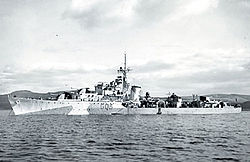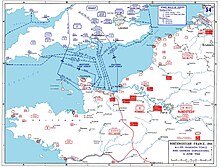Svenner (G03)
|
The Svenner in front of Scapa Flow
|
||||||||||||||||||||||||
|
||||||||||||||||||||||||
|
||||||||||||||||||||||||
|
||||||||||||||||||||||||
|
||||||||||||||||||||||||
The Norwegian Svenner (G03) was a destroyer of the British S-Class . The ship was part of the January 1941 fifth order of destroyers for the Royal Navy from the War Emergency Program . The destroyer was launched as one of the last of the S and T classes as HMS Shark . When the destroyer was completed at the Scotts shipyard on March 1, 1944, the Norwegian Navy took over the destroyer as Svenner on loan.
The very short service time of the Svenner ended on the morning of June 6, 1944 in front of the Sword Beach landing section in Normandy , when she was hit amidships by a torpedo from a German torpedo boat of the 5th Torpedo Boat Flotilla. The Svenner broke and sank. 34 Norwegian and one British crew members lost their lives in the sinking of the destroyer. The destroyer was the only Allied ship that was sunk by the Navy on the day of landing .
Building history
The Svenner was an S-class destroyer and displaced 1710 ts as standard and fully loaded 2530 ts. Like its sister ships, the destroyer had a length of 362 ft 9, a width of 35 ft 8 in and a draft of up to 14.5 ft. It was propelled by two Parson gear turbine sets, each of which drove a propeller shaft. The total drive power of 40,000 PSw was generated with the steam from two Admiralty boilers and gave the ship a top speed of over 36 knots . At full load, the Svenner could carry up to 615 ts of fuel, with which she could cover up to 4675 nm at a cruising speed of 20 kn. Their crew normally consisted of 170 men.
The destroyer was armed with four 4.7-inch (120 mm) / L45-Mark XII guns , which became real multi-purpose weapons thanks to the new mount with a large elevation range. A Bofors 40 mm twin gun in a Hazemeyer type carriage developed in the Netherlands and four automatic twin cannons of the 20 mm Oerlikon type were also available to ward off air attacks . In addition, the destroyer was armed with two 21 inch quadruple torpedo tubes and usually had 70 depth charges on board, which were deployed via two drainage rails and four launchers.
The ship was awarded in the fifth, in January 1941 as part of the War Emergency Program order of destroyers for the Royal Navy as a second order to the Scotts Shipbuilding and Engineering Company in Greenock . Construction of the ship began in Greenock in November 1941, three months after the sister ship Serapis , which was also to be built by Scotts . On June 1, 1943, it was launched as the Shark for the Royal Navy . When it was put into service on March 11, 1944 as the last ship of the class, it was taken over by the Norwegian Navy in Exile as Svenner and took on the British registration G 03 . The seven sister ships and the eight T-class ships were already in service, including the Stord of the Norwegian Navy, built by White as HMS Success since November 1943 . Before the Norwegian Navy, in addition to Commonwealth navies, the Polish and Dutch navies had received new British destroyers.
Mission history
After the commissioning Svenner was assigned to the 23rd destroyer flotilla of the Royal Navy, which consisted of the destroyers of the S-class and had distinguished itself at the turn of the year 1943/1944 when the Scharnhorst was sunk in the North Sea. The other Norwegian destroyer Stord also belonged to the flotilla . The still necessary acceptance tests and the break-in of the Svenner crew took place at the Home Fleet in Scapa Flow . As early as April, the new destroyer was assigned to the support forces for the planned invasion of Normandy. The Svenner was supposed to provide artillery support to the landed troops in the Sword landing section and to fight the German coastal fortifications near Cabourg . At the beginning of May the ship moved to the English Channel .
At the beginning of June, the Svenner and other destroyers of the 23rd Flotilla led the units from the Clyde to the Solent intended for the Sword landing section . From there, the units intended for artillery support and the landing ships then crossed the English Channel on the night of June 6, 1944 behind minesweepers.
In the early morning two battleships, a monitor, five cruisers, over ten destroyers and escort vehicles had reached their positions and began to bombard the German coastal positions behind a curtain of smoke from Douglas Boston of the RAF.
The Svenner was hit at around 5:30 a.m. by two torpedoes from the 5th torpedo flotilla under Corvette Captain Heinrich Hoffmann, which had advanced from Le Havre to the landing area . The Germans left an hour earlier. With the three torpedo boats T 28 , Jaguar and Möwe , they were able to approach the British attack force unnoticed up to torpedo range through the smoke curtain laid by the Allies, which they initially took for sea fog. Allied forces were focused on the shelling of the coast, which was about to begin, when the Germans attacked at high speed. The Germans, surprised by the size of the landing fleet, fired a volley of fifteen torpedoes and immediately withdrew from the vastly superior British. At least Arethusa shot at the torpedo boats. T 28 suffered a hit that put the radio out of operation.
The Svenner was hit amidships, broke after an explosion and the bow and stern sections protruded for a while out of the water. The stern then sank quickly and the sunken bow section could still be seen a few days later. 32 Norwegians and one British crew member were killed. 185 men, including 15 wounded, were saved. The shipwrecked were rescued by some ships hurrying to help. The sister ship Swift saved 67 men, while most of the ships carried out their operational orders in support of the landing troops.
The other torpedoes could be dodged or they missed their targets, so that the British Association had no further victims to complain about.
The Svenner was the only Allied ship that was sunk by the Navy on the day of landing. The wreck lies today in 31 feet of water to 49 ° 28 ' N , 0 ° 15' W . The anchor of the Svenner was raised in 2003 and erected as 'The Svenner Memorial' on Sword Beach near Hermanville-sur-Mer .
Renewed use of the name
From 1967 the Norwegian Navy had a name successor with a Kobben-class submarine , which was named Svenner . The class 207 boats built by the Nordseewerke in Emden were the first submarine exports in Germany. The submarine Svenner entered service in the Norwegian Navy on June 12, 1967 as the 15th and last boat of the class.
The boat, which was decommissioned in Norway, came to Poland in 2003 as ORP Bielik as the second of four boats.
Individual evidence
- ^ HMS Shark , then HNoMS Svenner on ClydeSite Clyde Ships Database
- ^ Lenton, p. 174
- ↑ English, pp. 62f.
- ^ Rohwer: Sea War , June 6, 1944 Canal: Allied Invasion ("Decision Day") in Normandy.
- ↑ The bombardment group included the battleships Warspite , Ramillies , the Monitor Roberts , the cruisers Mauritius , Arethusa , Dragon , Danae and Frobisher and more than ten destroyers and escort vehicles
- ^ Rohwer: Seekrieg , 6.– 13.6.1944 Canal / North Sea Attack attempts by German surface ships against the invasion fleet.
- ^ " Uboat.net:41 Norwegians and 2 British died, 187 of the crew survived. "
- ↑ Anchor Norwegian Destoyer Svenner with image
Web links
- HNoMS Svenner
- Service history HNorMS SVENNER (G 03), ex-HMS SHARK - S-class Destroyer
- "S", "T", "U", "V" and "W" destroyers (1943–1944)
literature
- Roger Chesneau (Ed.): Conway's All the World's Fighting Ships 1922-1946 , Conway Maritime Press (Greenwich, 1980), ISBN 0-85177-146-7
- John English: Obdurate to Daring: British Fleet Destroyers 1941-45 , World Ship Society (Windsor, 2001), ISBN 978-0-9560769-0-8
- Henry Trevor Lenton: British & Empire Warships of the Second World War , Naval Institute Press (Annapolis, 1998), ISBN 1-55750-048-7
- Alan Raven / John Roberts: War Built Destroyers O to Z , Bivouac Books (London, 1978), ISBN 0-85680-010-4
- Jürgen Rohwer , Gerhard Hümmelchen : Chronicle of the Naval War 1939-1945 , Manfred Pawlak VerlagsGmbH (Herrsching 1968), ISBN 3-88199-009-7
- MJ Whitley: Destroyers of World War 2 , Naval Institute Press (Annapolis, 1988), ISBN 0-87021-326-1


